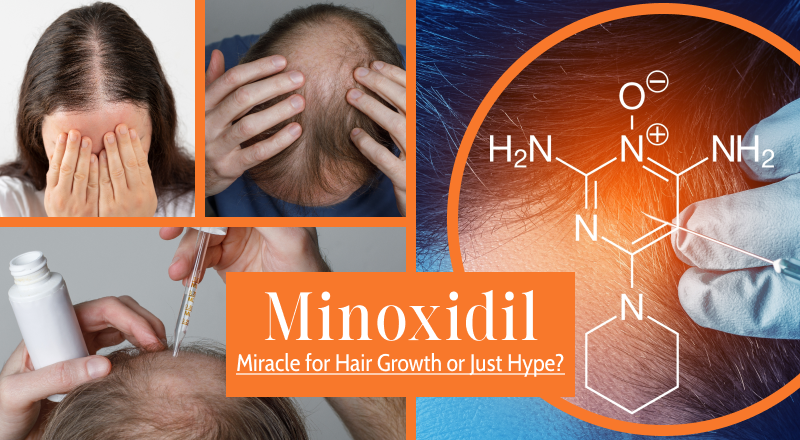
Minoxidil is an active substance that has been used for years in the treatment of hair loss. It was discovered accidentally in the 1970s when studies on its vasodilating effects revealed an unexpected result – hair growth. Minoxidil is now one of the most commonly used medications for treating androgenetic alopecia in both men and women.
Properties of Minoxidil
Minoxidil works by dilating blood vessels in the scalp, improving microcirculation in hair follicles, which stimulates their growth. Regular use leads to an increase in the number of active hair follicles and accelerates the hair growth cycle.
Key properties:
- Hair growth stimulation – Minoxidil stimulates hair follicles, shortening the hair’s resting phase and speeding up its growth cycle.
- Improved scalp circulation – The substance dilates blood vessels, enhancing the supply of nutrients to hair follicles.
- Hair loss delay – Using Minoxidil can slow down androgenetic alopecia and other forms of hair loss.
Who Can Benefit from Minoxidil?
Minoxidil is primarily used by individuals with hair loss problems, particularly androgenetic alopecia, in both men and women. Here’s who may benefit the most from its effects:
- Men with androgenetic alopecia: Minoxidil works on the typical form of hair loss, characterized by a receding hairline and balding at the crown.
- Women with androgenetic alopecia: Applied in lower concentrations, Minoxidil is also effective in treating hair thinning in women.
- People with alopecia areata: While Minoxidil is not the first-choice treatment for this condition, it can be used as a supplemental therapy.
How to Use Minoxidil
Minoxidil is available in various forms, such as solutions, foams, and sprays. It is important to follow the recommended dosage and application instructions:
- Topical application: Minoxidil is applied directly to the scalp, usually twice a day.
- Duration of treatment: To see results, regular use is necessary for at least 3–6 months.
- Application rules: The product should be applied to dry scalp, and hair washing should be avoided for at least 4 hours after application.
Things to Keep in Mind When Using Minoxidil
- Consistency: Minoxidil requires consistent use. Discontinuing treatment may result in the loss of gained effects.
- Side effects: The most common side effects include scalp irritation, dryness, and itching. In rare cases, excessive facial hair growth may occur.
- Not for everyone: Minoxidil is not effective for hair loss caused by factors other than androgenetic alopecia, such as scalp damage or scarring alopecia.
Side Effects of Minoxidil
Although Minoxidil is considered safe, some side effects may occur:
- Scalp irritation: Some individuals may experience redness, dryness, or itching on the scalp.
- Temporary hair loss: In the early stages of treatment, there may be a temporary increase in hair shedding, which is a normal response to the activation of new hair follicles.
- Excessive hair growth: In some cases, Minoxidil may cause excessive hair growth on the face and other parts of the body, especially in women.
Minoxidil vs. Other Hair Growth Substances
Minoxidil is one of the most researched and commonly used hair growth agents, but there are other substances available, such as finasteride, which works by inhibiting the hormone DHT responsible for androgenetic alopecia.
Conclusion
Minoxidil is an effective active ingredient used in hair loss therapy, stimulating hair growth and improving scalp microcirculation. Its regular use can help slow down hair loss and support healthy hair growth, particularly in cases of androgenetic alopecia. For the best results, consistent application is required, with noticeable effects appearing after several months.

Comments
No comments.
Add Comment